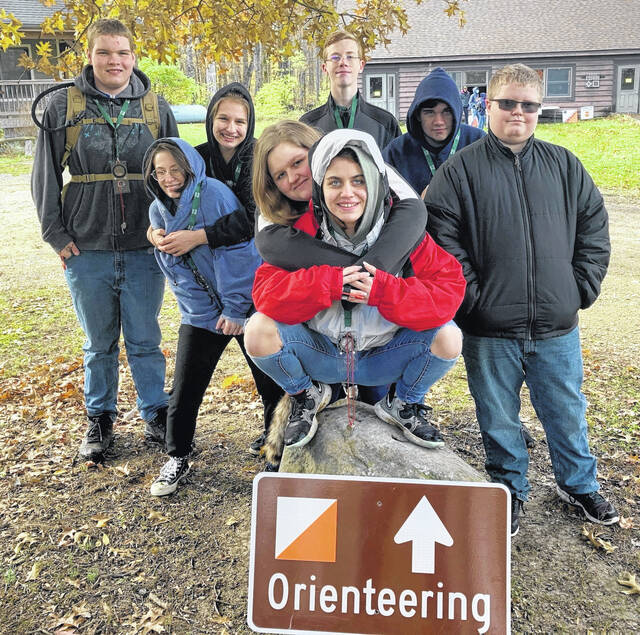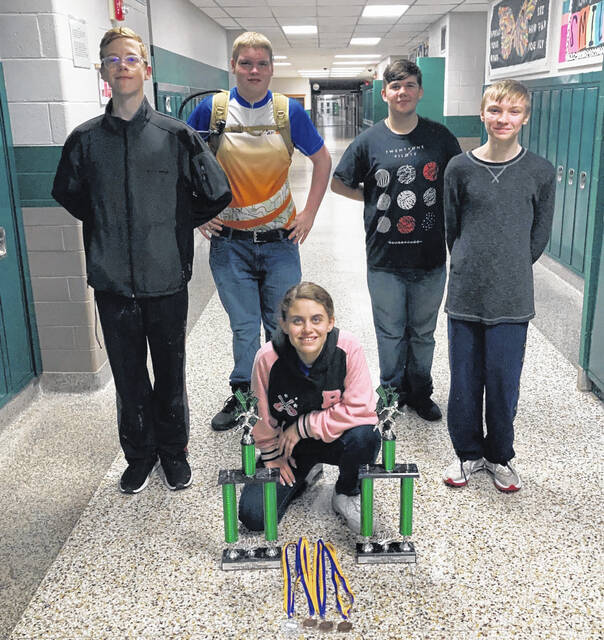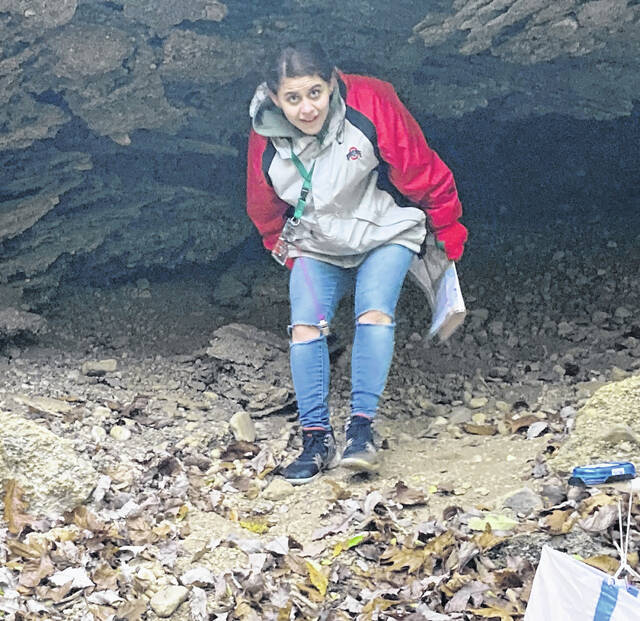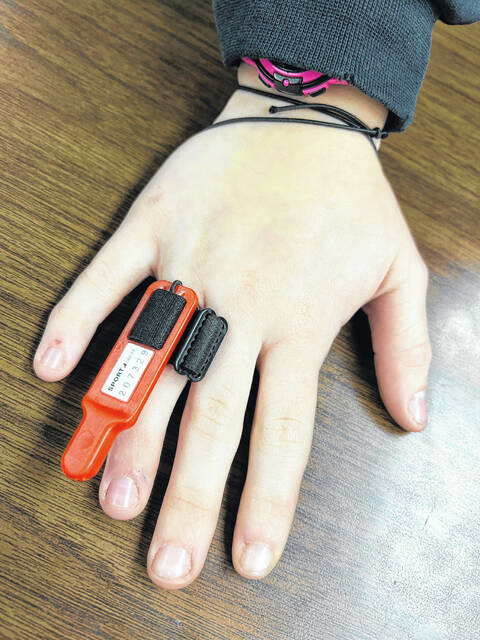
Tools of the trade include maps, compass, emergency whistle, and “cheat sheet” for high difficulty courses.
Dawn Hatfield | The Daily Advocate

NJROTC Orienteering Team at Greenville High School features a core group and several additional floating members.
Courtesy of CDR Win Knowles, USN(ret)

The Greenville High School NJROTC Orienteering Team placed third overall in Area 3 this year, which earned them an automatic invitation to Nationals. Eight team members represented Greenville in the event. last month.
Courtesy of CDR Win Knowles, USN(ret)

Junior Hailey Smith, the second-most tenured orienteer on the team, is pictured along a course during competition.
Courtesy of CDR Win Knowles, USN(ret)

E-sticks worn by participants use microchips to electronically register at check-points throughout each course.
Dawn Hatfield | The Daily Advocate
By Dawn Hatfield
DailyAdvocate.com
GREENVILLE — Greenville High School’s NJROTC Orienteering Team recently received an invitation to the Navy’s National Orienteering Championship to be held in California in March.
It has been described as “the greatest sport you’ve never heard of,” so, what exactly is orienteering? NavigationGames.org explains, “Orienteering is a sport where competitors use a map and a compass to find a series of checkpoints. There is no marked path, so participants must choose their own routes from one checkpoint to the next.”
Greenville High School NJROTC Orienteering Team Captain, CDT Jordan Ditty (senior), elaborated, “It’s like a scavenger hunt in the woods, and you’re running to find your points.”
CDR Winford “Win” Knowles, USN (ret.), now in his third year as Senior Naval Science Instructor for Greenville High School (Ohio) NJROTC, added, “It’s geocaching only no electronic stuff; it’s a map and a compass. It’s a timed event; the fastest times typically win. It’s not a group start; it’s usually individual starts that are spaced out so that people aren’t just running together.”
Knowles noted that successful orienteers must be smart and must have physical endurance. “It’s an interesting sport; it takes two real skills. One is, you’ve gotta be smart. You’ve gotta be able to read and interpret a map, figure out if it’s a cliff in front of you or just a field, which is often not easy to do. And then you have to have pretty good endurance because it’s a timed event, so you’re going to be running three to five kilometers,” said Knowles.
“[Course levels] are divided into difficulty and length. White is the easiest — you’re on a trail and typically just go on a big loop around. Yellow — you might walk off the trail, but you can typically see the trail from where you are. Orange — you will go off the trail (by 50 to 100 yards) 20 to 30 percent of the time. Brown — up to 80 percent off-trail,” explained Ditty.
Knowles interjected, “Markers are generally difficult to locate [on Brown trails and above].”
Ditty finished, “After that, the next colors are the same difficulty; they’re just longer, more spaced out, and may have some zig-zags—Green followed by Red.”
When asked how orienteers mark their progress, CDT Hailey Smith (junior), the second-most tenured of the team said, “One way is electronic — it’s an E-stick — you have it wrapped around your finger and you stick it into the device that reads it. Another way is paper, where each number has a different symbol that you hole-punch on the actual card itself.”
Knowles elaborated, “Typically, there are four to six courses — all those different colors are all out there — so, you can be running and see something, and it might be a marker for the Orange course when you’re doing the Brown course. So you have to check the numbers on them to make sure you’re punching the right ones.”
Ditty shared an example of the course challenges, “One little fun thing — I ran a Green course, and they put the point inside the hollowed-out tree stump. It had a little notch cut out where I’m guessing a little animal may have tunneled through, so, if you approached it from any wrong angle, you would not see it.”
“The map comes with kind of a little ‘cheat sheet’ that tells you what kind of feature [the checkpoint] is by, like it might be a big rock or a dead tree,” Knowles added. “Typically, it may be about five kilometers (approximately three miles) for a Brown course; four to five miles would be a Red course, probably. So there are little clues, but they’re not obvious clues. This is a challenging thing to do.”
Smith made an important suggestion, “Wear proper clothing. I usually wear (old) jeans, because if you wear any other type of fabric, especially going through thorn bushes, they can get torn up pretty easily. And depending on how cold it is, I might wear a jacket or a hoodie. Down in Texas, we wore shoes that were ankle-supported so we wouldn’t roll our ankles in between the rocks.”
When asked about competition length, Knowles answered, “Typically, a good runner at his/her skill level will finish a course in an hour to an hour and a half. If you’re off your skill level, you can be out there for three or four hours.”
The GHS NJROTC Orienteering Team traveled to Bridgeport, Texas, this summer for Orienteering Camp at Sid Richardson Scout Ranch. They completed 11 courses in five days, including night courses, known as Night-O. This was excellent preparation for the Area 3 Championships held at Camp Butterworth in Maineville, Ohio, last month.
On Nov. 13 to 14, the Greenville High School NJROTC Orienteering Team won third place out of 60 schools across 14 surrounding states in the inaugural NJROTC Area 3 Orienteering Championships. With this win, the team received an automatic invitation to compete in NJROTC Nationals, which will be held March 10 to 15 in Mt. Hamilton, Calif. It is a tremendous honor to be one of the 35 teams invited out of 660 units across the country.
“Needless to say, it is a BIG deal when any of Greenville High School’s teams or athletes advance to even a district or regional championship event. I am extremely proud of my students and their achievements this year,” said Knowles.
Visit www.navigationgames.org for basic information about orienteering or www.ocin.org/home.php for information on Orienteering Cincinnati, the local chapter.
Dawn Hatfield covers education stories for The Daily Advocate. Have a school-related event to share? Reach out by email at [email protected] or by phone at 937-569-0066.




